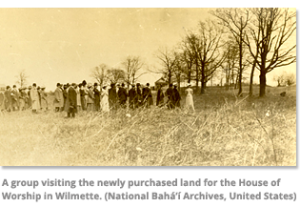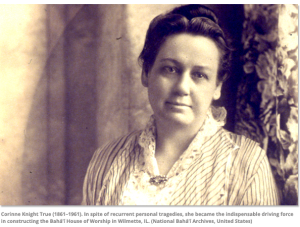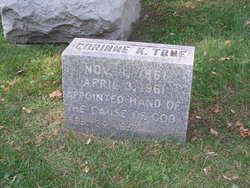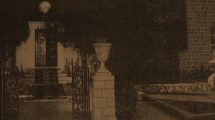 Corinne Knight True
Corinne Knight True
Born: November 1, 1861
Death: April 3, 1961
Place of Birth: Oldham County, Kentucky
Location of Death: Willmette, Illinois
Burial Location: Oak Woods Cemetery, Chicago, Illinois
Corinne Knight True was born in Kentucky [1-4] during the Civil War, the oldest child of Martha Thomas (Duerson) Knight (1839-1901) and Moses Greene Knight (1819-1903) [1-vi]. Skillful real estate investments in Chicago downtown property made Moses Knight prosperous, but when the Great Chicago Fire of 1871 swept the city, followed by the 1873 depression, Knight had to sell all his Kentucky property and move his family to Chicago to preserve his investments [1-7]. Financial success enabled Knight to send his daughter to Miss Mary Baldwin’s finishing school in Virginia. A few months after graduation, on November 24, 1882, Corinne Knight eloped, marrying Moses Adams True (1857-1909), the son of a next-door neighbor [1-10 to 13]. Moses Knight opposed his daughter’s marriage and the resulting bitter divide between father and daughter, who formerly had been close, lasted ten years.
The Trues had eight children in rapid succession: Harriet Merrill (1883-92) [1-14,18]; Lawrence Knight (1885-1906) [1-vii]; Charles Gilbert Davis (1886-1912) [1-vii]; Edna Miriam (1888-1988); Arna Corinne (1890-1975) [1-viii]; twins Katherine (1893-1963) [1-viii] and Kenneth (1893-1901) [1-27]; and Nathanael (1896-1899) [1-21,22]. The family was close and prosperous; they hired a cook and sent the children to private school. The loss of four of the children before adulthood produced a series of successive blows that severely tested Corinne True and turned her thinking toward religion. After Harriet fell down the stone basement stairs and died at age nine, Corinne and Moses True turned away from mainline Protestantism to some newly developed approaches to religion: the Unity School of Christianity, then Christian Science, then Divine Science [1-18]. When the baby of the family, Nathanael, died from complications following diphtheria in 1899 Corinne deepened her religious search. Through a friend she encountered the Bahá’í Faith late in 1899 and accepted it within a few months, at age thirty-eight [1-24]. In contrast, her husband was very sympathetic to Bahá’í beliefs but never formally joined.
When True became a Bahá’í the American Bahá’í community numbered 1500 to 2000 and was five years old. The Bahá’í religion began in 1863 when an Iranian noble named Mírzá Husayn-`Alí (1817-92), known as Bahá’u’lláh, founded a new religion based on such principles as the oneness of God, the spiritual unity of the world’s religions, the oneness of humanity, independent individual search for truth, and the equality of the sexes. A practical religion, it quickly spread beyond Iran and attracted Jews, Christians, Zoroastrians, and Buddhists as well as Muslims. When Bahá’u’lláh died his son `Abdu’l-Bahá (1844-1921) became head of the Faith.
It is not known what attracted True to the Bahá’í Faith, though its universal nature and inclusiveness were probably factors. She immediately became one of Chicago’s most active Bahá’ís. When, in May 1901, the Chicago Bahá’ís elected an all-male governing body to run the community and a women’s Auxiliary Board to assist, True became corresponding secretary of the latter [4-49-50]. In March 1902 True delivered a talk at the Chicago Bahá’í Sunday program titled “Fundamental Points of Behaism [sic]” and its contents indicate True’s understanding of the Bahá’í Faith was as good as any of the other Chicago Bahá’ís’ at the time [paper in Chase Papers, National Bahá’í Archives].
True wrote ‘Abdu’l-Bahá about the exclusion of women from the Chicago Bahá’í governing body on 25 February 1902, noting that “many” felt it should be a “mixed board” because “women in America stand so conspicuously for all that is highest & best in every department.” [3-23] In his response `Abdu’l-Bahá stated that while “in the sight of God, the conduct of women is the same as that of men” and there was “no difference” between the sexes, nevertheless the “House of Justice” had to consist only of men and that the “reason will presently appear, even as the sun at midday.” [3-25]
True accepted ‘Abdu’l-Bahá’s ruling–which also affirmed the equality of the sexes–and poured her energy into the Chicago Bahá’í women’s organization, which `Abdu’l-Bahá highly praised [3-21]. For the next eight years Chicago had two parallel Bahá’í organizations, one confined to men, the other to women. True served as president or secretary of the women’s body at different times. By 1903 she had been instrumental in establishing the first Bahá’í communities in Michigan–in Muskegon and Fruitport–near her family’s summer residence. She also traveled to Wisconsin to speak about the Bahá’í Faith. [4-140]
In 1903 the Chicago Bahá’ís heard about the construction of the world’s first Bahá’í House of Worship, in what is today Turkmenistan. They wrote `Abdu’l-Bahá asking for permission to build a temple of their own [4-118-19]. `Abdu’l-Bahá not only sent them two encouraging letters in response, but wrote True and encouraged her to get involved in the effort [1-41] [4-119]. She was surprised, as previously she had not been interested.
In spite of ‘Abdu’l-Bahá’s encouragement, nothing was done for several years. But on August 5, 1906 True’s oldest son, Lawrence, drowned during a sailing race on Lake Huron [1-48-49]. The young man had just finished college and was about to get married. True reevaluated her own life as a result and decided to redirect her energy to the construction of the temple. She went to Akka, Palestine to meet `Abdu’l-Bahá, spending six days with him in late February 1907. He gave True detailed instructions about building a Bahá’í House of Worship in America [1-60-61]. When three prominent Chicago men arrived a few weeks later, `Abdu’l-Bahá told them to work with True and that all his instructions for the Chicago Bahá’ís had been given to her [1-71].
Returning to Chicago in the spring of 1907, True began searching the area for potential building sites, especially those on the lake shore. The House of Spirituality (the Chicago Bahá’í governing body) named her treasurer of the temple work. Since the project grew to an international effort, she wrote hundreds of letters to Bahá’ís and Bahá’í communities around the world. `Abdu’l-Bahá wrote True and the House of Spirituality encouraging them to work together and resolving any friction that arose between them. In late November 1907 the House of Spirituality hosted an informal convention of representatives of various Bahá’í communities from around North America to build support for the temple. True did much of the planning for the convention, which was largely held at the True home in Chicago [1-78].
In mid March 1908 True found a site at the corner of Linden Avenue and Sheridan Road in Wilmette [4-296]. A newly-excavated drainage canal bounded the site on one side and Lake Michigan on another; the plot also possessed some elevation. The site’s natural advantages, however, were offset by practical concerns; it was several hours from downtown Chicago on public transportation [4-298]. In spite of this problem and the resulting opposition from some Chicago Bahá’ís, the House of Spirituality purchased the site on April 9, 1908. [4-297].
True believed the choice of a site necessitated the establishment of a formal, national organization, for the building would be a national House of Worship, not local. She wrote `Abdu’l-Bahá proposing that the American Bahá’ís create a national organization. In late August 1908 he replied that he was “very much pleased” with her plan, which called for the national coordinating body to be chosen by delegates selected by the various local Bahá’í communities across the United States and Canada. He added that women should be included. [4-299]
The first convention of the Bahai Temple Unity was held in March 1909 in Chicago, with several sessions held at the True home [1-82-83]. The convention formally approved the Wilmette site for the House of Worship and elected nine Bahá’ís to serve on the Executive Board of the Bahai Temple Unity [1-83]. Three were women; one was Corinne True, who was subsequently chosen as the board’s financial secretary. Thus she continued the role she had played for the temple on behalf of the Chicago Bahá’ís [1-83].
True’s devotion to the temple project became her chief solace as another round of tragedies befell her. In mid December 1909 Moses True died suddenly of a massive heart attack at the age of 52 [1-82]. The following summer her sole surviving son, Charles, caught tuberculosis, succumbing in April 1912 [1-100]. He died the night before `Abdu’l-Bahá arrived in Wilmette to dedicate the temple site. True attended the dedication in spite of her grief. Before the ceremony `Abdu’l-Bahá spent some minutes offering her consolation in private [1-101].
During `Abdu’l-Bahá’s visit to Chicago in 1912 He definitively removed all restrictions on the service of women on local Bahá’í institutions. True was one of the first group of three women to be elected to the nine-member Chicago House of Spirituality that year. One unexpected result of True’s local and national duties was that she no longer had time to devote to Bahá’í women’s activities. Across North America such bodies largely disappeared after 1912, once women were elected to local Bahá’í governing bodies instead.

Throughout the 1910s True was simultaneously a member of the Chicago and national Bahá’í coordinating bodies and served as financial secretary of the temple project [1-138]. She traveled to Hawaii and California to lecture about the Bahá’í Faith [1-120-21]. In 1919 True made a second pilgrimage to Akka, Palestine, visiting with `Abdu’l-Bahá in November of that year [1-142]. She attended the Bahai Temple Unity convention in 1920, which formally approved a design for the House of Worship [1-148]. The Wilmette temple was a unique blend of eastern and western architectural elements; its pillars were reminiscent of minarets and it was decorated with Middle Eastern designs, though it was composed of ornamental concrete and Portland cement over structural steel. Like all Bahá’í temples it had nine sides, a dome, and formal gardens around it.
On November 29, 1921, `Abdu’l-Bahá died peacefully at age seventy-seven. The True home was plunged into intense grief, for True, like other prominent Bahá’ís, had developed a very close and special relationship with `Abdu’l-Bahá. True served a pivotal role in consoling the Bahá’ís, whose morale was severely affected by the crisis. [1-151]
‘Abdu’l-Bahá’s had appointed his grandson Shoghi Effendi (1897-1957) as his successor and  Guardian of the Bahá’í Faith. True had already met Shoghi Effendi on her 1919 pilgrimage and had corresponded with him [1-143]; thus she was in an excellent position to rally the Bahá’ís behind him. In early 1922 Shoghi Effendi invited a group of about fifteen prominent Bahá’ís from around the world to come to Haifa and consult with him about the future development of the Faith [1-155]. Four members of the Bahai Temple Unity Executive board were invited, including True.
Guardian of the Bahá’í Faith. True had already met Shoghi Effendi on her 1919 pilgrimage and had corresponded with him [1-143]; thus she was in an excellent position to rally the Bahá’ís behind him. In early 1922 Shoghi Effendi invited a group of about fifteen prominent Bahá’ís from around the world to come to Haifa and consult with him about the future development of the Faith [1-155]. Four members of the Bahai Temple Unity Executive board were invited, including True.
Over the next few years the Bahai Temple Unity Executive Board, under Shoghi Effendi’s direction, evolved into a new body, the National Spiritual Assembly of the Bahá’ís of the United States and Canada, and internationally uniform guidelines for conducting Bahá’í elections and carrying out Bahá’í administrative activities were created [1-160-61]. True wished to devote her time exclusively to the Temple, a task that was the National Spiritual Assembly’s most important responsibility. She no longer served on the American Bahá’í coordinating body after 1923 but continued to be appointed financial secretary of the temple project through 1927 [1-162]. Subsequently she served on various national committees, especially those related to the temple project [1-177]. In 1930 True moved to Wilmette from Chicago to be closer to the House of Worship, which was then partially built [1-169].
True went on several more pilgrimages to meet with Shoghi Effendi during the 1920s and 1930s. Her last meeting with him was in Haifa in 1952, when she was ninety-one years old. She also made lecture tours of western Europe in 1947 and 1950 in order to assist the new Bahá’í communities there [1-191]. In her later years True’s reputation grew and American Bahá’ís came to refer to her as “the mother of the Temple” and as “Mother True.” On February 29, 1952, Shoghi Effendi appointed Corinne True a “Hand of the Cause of God,” a special spiritual status within the Bahá’í community that includes no administrative authority, but conveys prestige and the privilege to counsel and advise Bahá’ís and their administrative institutions [5-20-21]. Of the nineteen Hands then living, four were women.
On May 2, 1953, True was one of several Hands attending the dedication of the Bahá’í House of Worship in Wilmette [1-208]. She was thus able to see the completion of the building to which she had devoted so much of her life. In April 1957–when True was 95–Shoghi Effendi appointed her as his official representative to attend the first election of the National Spiritual Assembly of the Bahá’ís of the Greater Antilles in the Caribbean [1-210]. It was True’s last trip outside the United States.
True’s failing health prevented further travel, but she was able to enjoy the family of her daughter Arna and watch two other daughters rise to the apex of their careers. Katherine, a Chicago physician and one of the first women named a fellow in the American College of Surgeons, served on the National Spiritual Assembly of the Bahá’ís of the United States from 1956 to 1960. Edna, a successful Evanston businesswoman, served on the National Spiritual Assembly from 1946 to 1968 and then was appointed a Counsellor, an international advisor to the Bahá’í community similar to a Hand of the Cause.
On November 4, 1957, Shoghi Effendi died suddenly. The Hands of the Cause assumed collective control of the Bahá’í Faith until the Universal House of Justice could be elected. Because of her frail health True was the only Hand unable to travel to Israel for the annual conclaves of the Hands. Nevertheless they kept her informed of all their decisions and asked her to sign notarized affidavits of assent supporting all important statements on which they had unanimously agreed [6-30-39].
Corinne True died peacefully in her Wilmette home on 3 April 1961, five months into her hundredth year [1-213]. She is remembered by the American Bahá’ís for her courage, faith, devotion, and persistence, and historically is one of the most prominent half dozen American Bahá’í women.

Source:
Stockman, Robert. “True, Corinne’ Bahai-Library.com: Winters, Jonah
Images:
Baha’i World Centre Archives
Sources provided by the Mr. Stockman: A short summary of parts of True’s life was published by Bruce Whitmore as “Mother of the Temple: The Story of Hand of the Cause of God Corinne Knight True,” in Bahá’í News, no. 538 (Jan. 1976): 1-10. Nathan Rutstein’s biography Corinne True: Faithful Handmaid of `Abdu’l-Bahá (Oxford: George Ronald, 1987) provides far more detail, but is a popular work that includes the author’s guesses as to True’s thoughts and feelings, and thus must be used with caution. Robert H. Stockman’s “Women in the Chicago Bahá’í Community, 1900-1912,” in World Order, vol. 25, no. 2 (winter 1993-94): 17-34, provides details of True’s involvement in Chicago Bahá’í women’s activities. Stockman’s Bahá’í Faith in America, Volume Two: Early Expansion, 1900-1912 (Oxford: George Ronald, 1995) describes her role in the temple project, including her first pilgrimage to meet `Abdu’l-Bahá. Most of the originals of True’s letters from `Abdu’l-Bahá may be found in the National Bahá’í Archives, Wilmette, Ill; some were published in Tablets of Abdul-Baha Abbas. Many of True’s letters to `Abdu’l-Bahá are in the International Bahá’í Archives in Haifa, Israel. The National Bahá’í Archives possesses a collection, the Corinne True Family Papers, but it is not yet organized and available to researchers. Correspondence to or from True may also be found in that archives’ Thornton Chase Papers, House of Spirituality Records, Albert R. Windust Papers, and several other collection





Add Comment